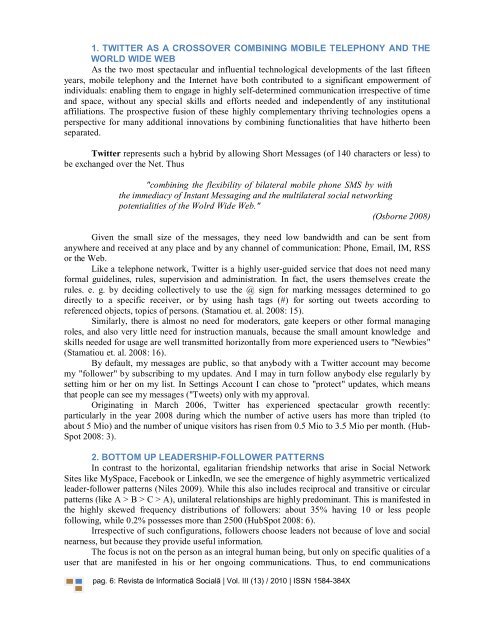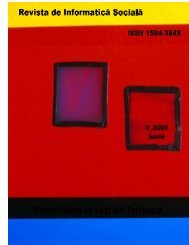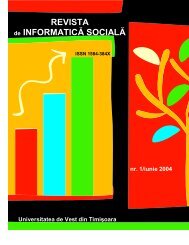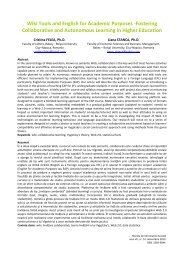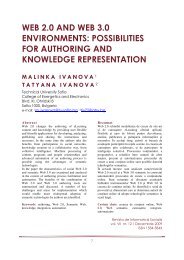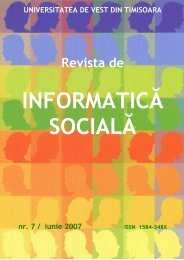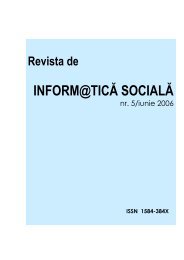No 13 - Journal of Social Informatics / Revista de Informatica Sociala
No 13 - Journal of Social Informatics / Revista de Informatica Sociala
No 13 - Journal of Social Informatics / Revista de Informatica Sociala
You also want an ePaper? Increase the reach of your titles
YUMPU automatically turns print PDFs into web optimized ePapers that Google loves.
1. TWITTER AS A CROSSOVER COMBINING MOBILE TELEPHONY AND THE<br />
WORLD WIDE WEB<br />
As the two most spectacular and influential technological <strong>de</strong>velopments <strong>of</strong> the last fifteen<br />
years, mobile telephony and the Internet have both contributed to a significant empowerment <strong>of</strong><br />
individuals: enabling them to engage in highly self-<strong>de</strong>termined communication irrespective <strong>of</strong> time<br />
and space, without any special skills and efforts nee<strong>de</strong>d and in<strong>de</strong>pen<strong>de</strong>ntly <strong>of</strong> any institutional<br />
affiliations. The prospective fusion <strong>of</strong> these highly complementary thriving technologies opens a<br />
perspective for many additional innovations by combining functionalities that have hitherto been<br />
separated.<br />
Twitter represents such a hybrid by allowing Short Messages (<strong>of</strong> 140 characters or less) to<br />
be exchanged over the Net. Thus<br />
"combining the flexibility <strong>of</strong> bilateral mobile phone SMS by with<br />
the immediacy <strong>of</strong> Instant Messaging and the multilateral social networking<br />
potentialities <strong>of</strong> the Wolrd Wi<strong>de</strong> Web."<br />
(Osborne 2008)<br />
Given the small size <strong>of</strong> the messages, they need low bandwidth and can be sent from<br />
anywhere and received at any place and by any channel <strong>of</strong> communication: Phone, Email, IM, RSS<br />
or the Web.<br />
Like a telephone network, Twitter is a highly user-gui<strong>de</strong>d service that does not need many<br />
formal gui<strong>de</strong>lines, rules, supervision and administration. In fact, the users themselves create the<br />
rules. e. g. by <strong>de</strong>ciding collectively to use the @ sign for marking messages <strong>de</strong>termined to go<br />
directly to a specific receiver, or by using hash tags (#) for sorting out tweets according to<br />
referenced objects, topics <strong>of</strong> persons. (Stamatiou et. al. 2008: 15).<br />
Similarly, there is almost no need for mo<strong>de</strong>rators, gate keepers or other formal managing<br />
roles, and also very little need for instruction manuals, because the small amount knowledge and<br />
skills nee<strong>de</strong>d for usage are well transmitted horizontally from more experienced users to "Newbies"<br />
(Stamatiou et. al. 2008: 16).<br />
By <strong>de</strong>fault, my messages are public, so that anybody with a Twitter account may become<br />
my "follower" by subscribing to my updates. And I may in turn follow anybody else regularly by<br />
setting him or her on my list. In Settings Account I can chose to "protect" updates, which means<br />
that people can see my messages ("Tweets) only with my approval.<br />
Originating in March 2006, Twitter has experienced spectacular growth recently:<br />
particularly in the year 2008 during which the number <strong>of</strong> active users has more than tripled (to<br />
about 5 Mio) and the number <strong>of</strong> unique visitors has risen from 0.5 Mio to 3.5 Mio per month. (Hub-<br />
Spot 2008: 3).<br />
2. BOTTOM UP LEADERSHIP-FOLLOWER PATTERNS<br />
In contrast to the horizontal, egalitarian friendship networks that arise in <strong>Social</strong> Network<br />
Sites like MySpace, Facebook or LinkedIn, we see the emergence <strong>of</strong> highly asymmetric verticalized<br />
lea<strong>de</strong>r-follower patterns (Niles 2009). While this also inclu<strong>de</strong>s reciprocal and transitive or circular<br />
patterns (like A > B > C > A), unilateral relationships are highly predominant. This is manifested in<br />
the highly skewed frequency distributions <strong>of</strong> followers: about 35% having 10 or less people<br />
following, while 0.2% possesses more than 2500 (HubSpot 2008: 6).<br />
Irrespective <strong>of</strong> such configurations, followers choose lea<strong>de</strong>rs not because <strong>of</strong> love and social<br />
nearness, but because they provi<strong>de</strong> useful information.<br />
The focus is not on the person as an integral human being, but only on specific qualities <strong>of</strong> a<br />
user that are manifested in his or her ongoing communications. Thus, to end communications<br />
pag. 6: <strong>Revista</strong> <strong>de</strong> Informatică <strong>Social</strong>ă | Vol. III (<strong>13</strong>) / 2010 | ISSN 1584-384X


